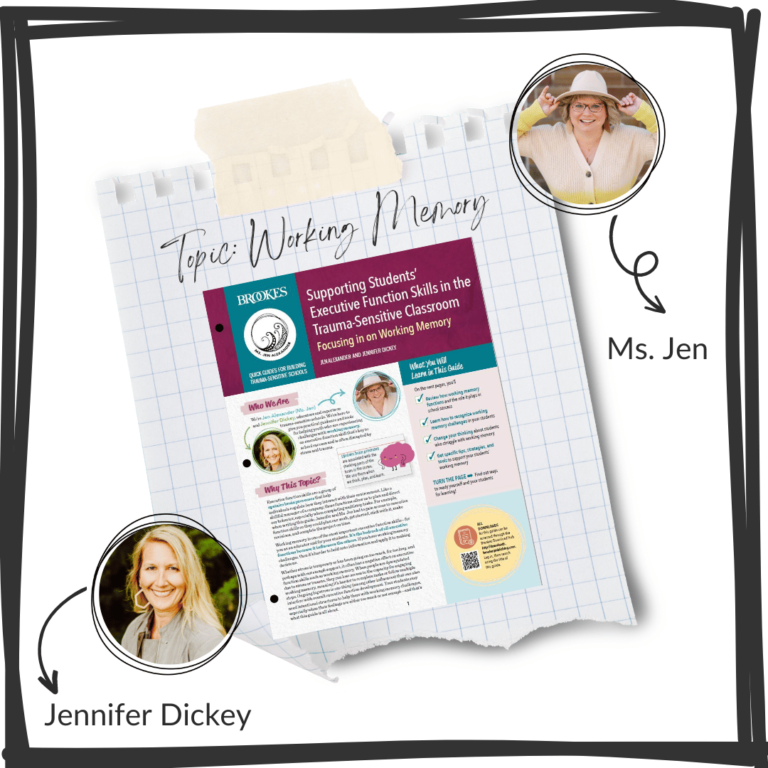When students are disengaged, educators often respond with, “It’s time to focus.” Or, “You’re choosing not to do the work.” . Maybe you’ve done this. If so, you’re not alone. What you may not realize is that these comments are based on incorrect assumptions. Often, it’s working memory difficulties that are getting in the way of following through with school tasks–not a lack of focus or wish to get out of the work.. Learn all about this approach in my new quick guide co-authored with executive function expert Jennifer Dickey and published by Paul H. Brookes Publishing Co. It will help you support working memory needs for both youth and adults. The colorful guide is organized into eight easy-to-read panels and gives you practical tips along with activities and downloads you can start using with your learners right away!
Each Quick Guide Answers a Trauma-Sensitive Question
Check out the titles, topics, and the guiding questions that sparked each quick guide, including this one on working memory (the second one listed below). Next, be on the lookout for future posts as new titles become available. There’s so much good stuff coming your way!
- Creating a Regulating Classroom Environment: A Guide for Trauma-Sensitive Educators by Ms. Jen Alexander and Anna Paravano (2023) answers the question, “What should educators do more of and less of when designing classroom or school spaces to promote regulation?” Additionally, read my previous blog post on this topic.
- Supporting Students’ Executive Function Skills in the Trauma-Sensitive Classroom: Focusing in on Working Memory by Ms. Jen Alexander and Jennifer Dickey (2024) provides answers to these trauma-sensitive questions. “What is working memory?” “How can high stress affect working memory for youth and adults at school?” And, “What can educators do to support learners’ working memory needs?”
Here are two tips from the working memory quick guide! The first suggestion is about prompting students to the next step, and the second is about how to challenge the assumption that someone is “manipulating.”
Support Working Memory by Prompting the Next Step
The video above explains how cuing folks to the next steps supports working memory needs in the classroom. It’s based on Ms. Jen’s work with Jennifer Dickey an executive function expert. (Reference: Alexander, J. & Dicky, J. (2024). Supporting Students’ Executive Function Skills in the Trauma-Sensitive Classroom: Focusing in on Working Memory. Paul H. Brookes Publishing Co.)
Challenge the Assumption of Manipulation
When youth can complete a multi-step task one day but struggle with it on a different day, adults may guess they’re trying to manipulate. Our capacity for holding information in working memory fluctuates based on stress levels and other factors, though, so expect that success with multi-step skills will vary too.
If you’ve ever been stressed and felt like you couldn’t hold onto information in a set of directions just given to you, you’ve experienced this yourself. Recently, I was stressed by personal news at the same time I was running on not enough sleep. While putting some furniture together with a friend, they looked at the directions and quickly explained the next several steps. Feeling frustrated, I couldn’t hold those long enough in my upstair brain to even get started with the first direction and had to ask for them to be repeated. Also, I looked at the directions (visual cue) to help myself. Keep in mind that I wasn’t manipulating my friend or trying to get out of the work. Rather, my capacity for holding information in my working memory was compromised.
Working memory challenges unfold daily for kids and adults in your school community. Never assume individuals are manipulating you.
If other adults are assuming manipulation, try one of these responses.
- “Sometimes we assume youth are manipulating when that’s really not the case. What else could be going on?
- “I wonder if working memory difficulties are part of the challenge.”
- “Try a working memory support to see if that helps.”
- “Check out Ms. Jen’s new quick written with Jennifer Dickey to learn more about supporting executive function!”
More Learnings for Supporting Working Memory
There’s much more you can learn from Jennifer Dickey and me (2024) in Supporting Students’ Executive Function Skills in the Trauma-Sensitive Classroom. This includes tips about recognizing working memory challenges and more strategies for supporting these skills in youth and adults.
Here’s what one high school teacher said about the guide, “While I teach multi-step processes for solving complex math problems, I don’t always teach and provide visual cues for how to email me for extra help. I’m going to explicitly teach and visually prompt youth for this and so much more moving forward.”
For more information about how to specifically teach (and cue) students to send emails to instructors, @heymrsbond on Instagram created a step-by-step guide for sending an email on July 10, 2023 that we highly recommend.
Please check out our new resource too and let us know what you decide to try! Also, stay tuned for more answers to trauma-sensitive questions in upcoming quick guides.

Take good care,




